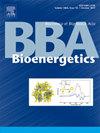Defining the direct electron transfer connection between alternative complex III and cytochrome oxidase in Flavobacterium johnsoniae
IF 2.7
2区 生物学
Q2 BIOCHEMISTRY & MOLECULAR BIOLOGY
引用次数: 0
Abstract
Alternative complex III (ACIII) is an enzyme of electron transport chains in some bacterial species. ACIII, like cytochrome bc enzymes, oxidizes quinol and transfers electrons from quinol to electron acceptors located outside the membrane. Various proteins can functionally link ACIII with other enzymes. The structure of ACIII from Flavobacterium johnsoniae suggests that in this bacterium the membrane-anchored mobile mono-heme cytochrome c domain (mdA) of the ActA subunit of ACIII provides means for its connection with cytochrome aa3 oxidase. Here, using a recently-developed genetic system for ACIII, we revealed that ACIII mutant deprived of mdA does not exhibit electron transfer activity towards cytochrome aa3 oxidase in the cells and in the isolated membranes. These results indicate that mdA is the only carrier of electrons between the pentaheme core of ActA and cytochrome aa3 oxidase. In addition, we heterologously expressed and purified mdA and ActE (another mono-heme subunit of ACIII) from Escherichia coli to identify the redox midpoint potentials of the hemes in these two domains. The obtained values analyzed in the context of the whole titration profiles of native ACIII and ACIII deprived of mdA provide first insights into the arrangement of heme redox potentials in the seven-heme chain formed by the ActA/ActE assembly.
确定琼氏黄杆菌中选择性络合物III与细胞色素氧化酶之间的直接电子转移联系。
选择性络合物III (ACIII)是一些细菌种类中的一种电子传递链酶。ACIII,像细胞色素bc酶一样,氧化喹啉并将电子从喹啉转移到位于膜外的电子受体。各种蛋白质可以将ACIII与其他酶连接起来。来自强johnsoniae黄杆菌的ACIII的结构表明,在该细菌中,ACIII的ActA亚基的膜锚定的移动单血红素细胞色素c结构域(mdA)为其与细胞色素aa3氧化酶的连接提供了途径。在这里,利用最近开发的ACIII遗传系统,我们发现剥夺mdA的ACIII突变体在细胞和分离膜中不表现出对细胞色素aa3氧化酶的电子转移活性。这些结果表明,mdA是ActA的五胺核和细胞色素aa3氧化酶之间的唯一电子载体。此外,我们从大肠杆菌中异种表达和纯化了mdA和ActE (ACIII的另一个单血红素亚基),以确定这两个区域血红素的氧化还原中点电位。在天然ACIII和剥夺mdA的ACIII的整个滴定谱的背景下分析所得值,首次深入了解了ActA/ActE组装形成的七血红素链中血红素氧化还原电位的排列。
本文章由计算机程序翻译,如有差异,请以英文原文为准。
求助全文
约1分钟内获得全文
求助全文
来源期刊

Biochimica et Biophysica Acta-Bioenergetics
生物-生化与分子生物学
CiteScore
9.50
自引率
7.00%
发文量
363
审稿时长
92 days
期刊介绍:
BBA Bioenergetics covers the area of biological membranes involved in energy transfer and conversion. In particular, it focuses on the structures obtained by X-ray crystallography and other approaches, and molecular mechanisms of the components of photosynthesis, mitochondrial and bacterial respiration, oxidative phosphorylation, motility and transport. It spans applications of structural biology, molecular modeling, spectroscopy and biophysics in these systems, through bioenergetic aspects of mitochondrial biology including biomedicine aspects of energy metabolism in mitochondrial disorders, neurodegenerative diseases like Parkinson''s and Alzheimer''s, aging, diabetes and even cancer.
 求助内容:
求助内容: 应助结果提醒方式:
应助结果提醒方式:


